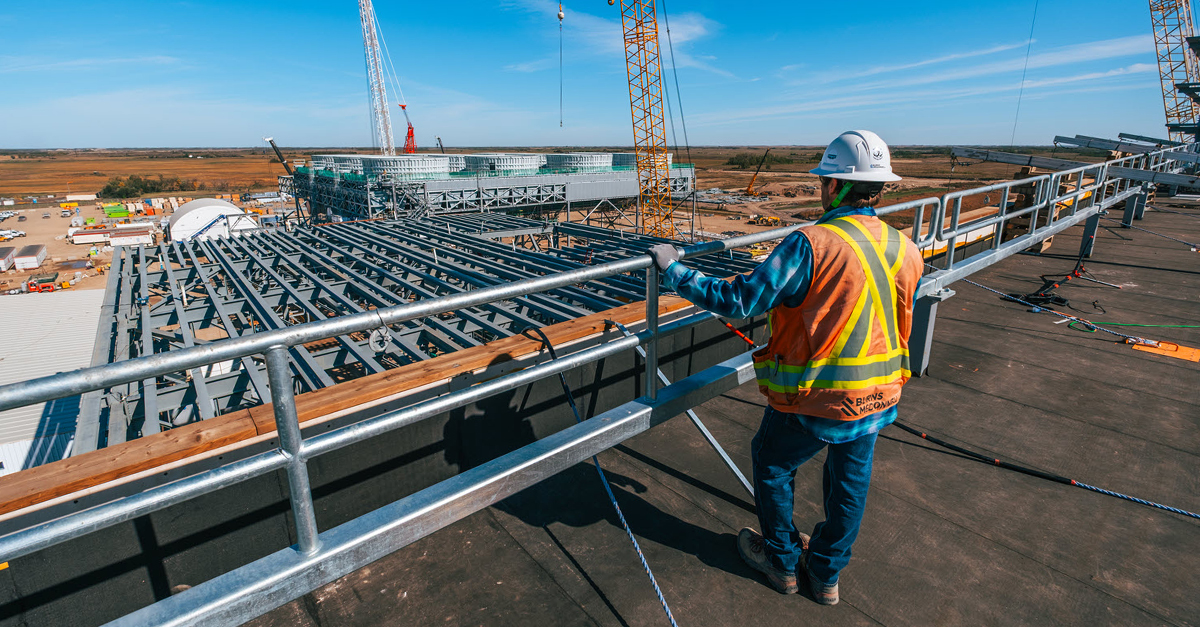Aspen Power Station Project Halfway Complete
November 06, 2025

Quotables:
- This fall, the Aspen Power Station project reached a major milestone of being more than 50% complete.
- “Surpassing the procurement goals we set with our build partner, Burns & McDonnell, demonstrates a strong commitment to inclusive economic development and growing a strong, local workforce.”
- “Aspen reflects SaskPower’s values and vision. It demonstrates how we can build responsibly, inclusively, and efficiently while preparing Saskatchewan and SaskPower’s electrical grid for the next 100 years.”
Construction of the new Aspen Power Station near Lanigan, SK has been underway for 18 months now since beginning in April 2024. This fall, the project reached a major milestone of being more than 50% complete.
To get a sense of how the project has been going, we sat down with Ryan Neufeld, Vice President of Engineering and Construction, and Riley Chesterton, Project Manager for the Aspen project, to talk about highlights, lessons learned, and why the project is important.
SaskPower (SP): Aspen Power Station is the third natural gas facility to be built by SaskPower in the past 10 years, after Chinook Power Station, which came online in 2019, and Great Plains Power Station, which came online in 2024. Why is Aspen needed and what makes it unique?
Ryan Neufeld (RN): Aspen is a key addition to our generation fleet, designed to provide reliable and flexible generation capacity for Saskatchewan’s power grid. It’s a 370-MW combined cycle power station, and what sets it apart is its ability to switch between simple and combined cycle modes. This means it can respond quickly to demand changes, which enhances our grid stability.
Riley Chesterton (RC): SaskPower has traditionally designed large natural gas facilities to operate only in combined cycle mode, using both gas and steam turbines together. For Aspen, we chose a design that would be the most efficient and cost-effective for baseload natural gas generation while enhancing the flexibility of the unit. This added flexibility means we can run Aspen in simple cycle mode when we need rapid generation to balance power load, or we can run it in efficient combined cycle mode to support renewables when wind and solar generation is high, or as full baseload power for extended periods of time.
SP: How is the construction going?
RN: Construction is moving along great. As of October, the project is 52% complete overall and on schedule for a December 2027 in-service date. More than 1.3 million hours have been worked without any lost-time injury.
RC: The site is buzzing with activity. Construction itself is now 30% complete. Structural steel is nearly done, and we’re progressing with piping, electrical work, and turbine installation. The gas turbine and generator arrived this summer from Germany and are now in place. We’ve poured over 10,500 cubic metres of concrete, including 948 used just to make the foundations for the gas and steam generators. Currently on site, there are 16 cranes in use to help set material, equipment and erect the buildings. This includes lifting 3,262 tonnes of steel into place and installing more than 62 kilometres of pipe and over 800 kilometres of cable.
SP: What does this look like in terms of activity on site?
RC: We’ve oriented more than 1,600 workers on site since construction began. There are currently 12 main subcontractor companies actively working on site with approximately 550 total workers each day including day and night shifts. We’re anticipating as many as 750 workers on site at the peak of construction in 2026. We’ve got 219 businesses that are either currently participating or have participated on the Aspen project. That includes 189 local, 21 Indigenous, and 9 women-owned businesses.
SP: One of the major highlights of the Aspen project is exceeding the procurement commitments that were set for local (Saskatchewan-based), Indigenous and women-owned businesses to be involved in the project. What does this mean and why is it important?
RN: Surpassing the procurement goals we set with our build partner, Burns & McDonnell, demonstrates a strong commitment to inclusive economic development and growing a strong, local workforce. This is important because it helps support the local economy and creates opportunities for a wider range of people and communities. By going above and beyond these goals, this project is an example of our commitment to building strong relationships and making a positive impact in Saskatchewan.
Our total spend to date with local companies has reached $558 million, which is 155% of our original target. Indigenous company spending stands at $263.5 million, which is 492% of the target; while our spend for women-owned businesses has received $29.5 million, or 118% of our goal.
SP: How did you achieve such great procurement results?
RC: We engaged with vendors early, well before construction started. This allowed them to plan and prepare for Aspen. Both SaskPower and Burns and McDonnell also participated in local vendor events to develop relationships and a vendor pool to be considered in the procurement phase of the project. We also developed a contract model with Burns & McDonnell that allowed us to share vendor databases and draw on Burns & McDonnell’s experience with vendors that participated in building Great Plains and Chinook Power Stations.
SP: How has the Aspen project contributed to communities throughout the region?
RC: The community has been extremely supportive of the Aspen project, and the team is trying to give back as much as possible. To date, we’ve given back approximately $69,750 to the community through sponsorships and donations, and spent about $163,000 locally on things such as food, site services, office supplies, and other miscellaneous items.
RN: Through Aspen, we’ve also fostered stronger relationships with local and Indigenous communities through consultations and continued engagement. The project has created jobs and supported local businesses.
SP: What are some other highlights from the project?
RN: Engagement and building relationships with Indigenous nations; from the pipe ceremony and site blessing before construction started to the ongoing engagement we’ve continued around procurement opportunities. We’ve enhanced internal processes for budget tracking and risk management. Safety performance has been exemplary and imbedded in every aspect of the project.
SP: How has being a part of this project impacted you? What are you most proud of?
RC: It feels like an honour and privilege to participate on a project of this scale. I know that successfully delivering Aspen will leave a positive impact on peoples’ lives and careers, including my own, and I’ve been given an amazing opportunity to work with world-class professionals who have come together to make that positive footprint in Saskatchewan. This same group of professionals has also come together to establish a world-class safety culture, which has created an inclusive, collaborative and efficient jobsite culture at Aspen, which I am very proud of as well.
RN: Aspen has been a career-defining project so far for me. I’m proud of the collaborative spirit and the way we’ve embedded innovation and accountability into every phase. I’m humbled to be part of such a professional dedicated team of experts that are leading this project.
SP: Are there any lessons learned through the Aspen project that will be valuable for future SaskPower projects?
RN: We’ve gained insights that will help us improve labour attraction and retention, procurement and give us better understanding of the specialized skills needed for this type of contract that can be used for other projects going forward.
SP: Anything else you’d like to share?
RN: Aspen reflects SaskPower’s values and vision. It demonstrates how we can build responsibly, inclusively, and efficiently while preparing Saskatchewan and SaskPower’s electrical grid for the next 100 years.
Visit saskpower.com/Aspen to learn more about the Aspen Power Station and sign up to stay informed about our progress.
Learn more:




